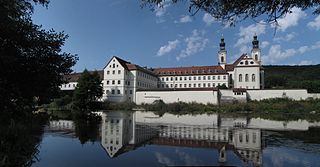History
The abbey at Pielenhofen for Cistercian nuns, dedicated to the Assumption of the Blessed Virgin Mary, was founded in 1240 by the lords of Hohenfels and Ehrenfels. In 1542, during the Reformation in Pfalz-Neuburg, it was placed under secular administration. In 1655, it was subordinated to Kaisheim Abbey as a sub-priory.
During the secularisation of Bavaria in 1803, the priory was dissolved; the nuns' church became a parish church. In 1806, Carmelite nuns from Munich and Neuburg an der Donau moved into the premises as a joint nunnery. In 1838, the Visitandines, also known as Salesian Sisters, bought it, and established a girls' school here. In 1981, the Pielenhofen Primary School, a boarding school of the Regensburg Cathedral Choir, replaced the earlier school. In 2010, the five remaining nuns moved to the community of the Visitandines at Zangberg. [1]

Neuburg Abbey near Heidelberg in Baden-Württemberg is a Benedictine monastery dedicated to Saint Bartholomew, and part of the Beuronese Congregation.

Marienrode Priory is a Benedictine nunnery in Marienrode, a district of Hildesheim in Germany.

Beuerberg Abbey, formerly a monastery of the Augustinian Canons, is now the Monastery of the Visitation, Beuerberg, a community of the Visitandines in Eurasburg in Bavaria, Germany.
Münsterschwarzach Abbey, is a monastery for Benedictine monks in Germany. It is located at the confluence of the rivers Schwarzach and Main in Bavaria.

Baindt Abbey, otherwise the Imperial Abbey of Baindt, was a Cistercian nunnery in Baindt in the district of Ravensburg in Baden-Württemberg, Germany.

The Imperial Abbey of Kaisersheim, was a Cistercian monastery in Kaisersheim, Bavaria, Germany.

Waldsassen Abbey is a Cistercian nunnery, formerly a Cistercian monastery, located on the River Wondreb at Waldsassen near Tirschenreuth, Oberpfalz, in Bavaria, Germany, close to the border with the Czech Republic. In the Holy Roman Empire it was an Imperial Abbey.

Oberschönenfeld Abbey is a Cistercian nunnery in Gessertshausen in Bavaria, Germany.

Pielenhofen is a municipality in the district of Regensburg in Bavaria in Germany. It lies on the Naab River.

Chotěšov Abbey is a former Premonstratensian nunnery in Chotěšov, about 18 kilometres southwest of Plzeň in the Plzeň Region of the Czech Republic.

Wienhausen Abbey or Convent near Celle in Lower Saxony, Germany, is a community of Evangelical Lutheran women, which until the Reformation was a Cistercian Catholic nunnery. The abbey owns significant artworks and artifacts, including a collection of tapestries and the earliest surviving example of a type of eyeglasses.

St. Marienthal Abbey is a Cistercian nunnery in Saxon Upper Lusatia. The abbey is the oldest nunnery of the Cistercian Order in Germany to have maintained unbroken occupation of its house since its foundation.

Sonnefeld Abbey is a former Cistercian nunnery in Sonnefeld in Bavaria, Germany. The former abbey church, or Klosterkirche, is now an Evangelical Lutheran parish church.

Geisenfeld Abbey was a convent in Bavaria, Germany, in the town of Geisenfeld. It was founded in 1037 and dissolved in 1804. At one time it was one of the most prosperous convents in Bavaria.

Maidbronn Abbey was a Cistercian nunnery in Maidbronn in the present municipality of Rimpar in Bavaria, Germany.
This page is based on this
Wikipedia article Text is available under the
CC BY-SA 4.0 license; additional terms may apply.
Images, videos and audio are available under their respective licenses.















